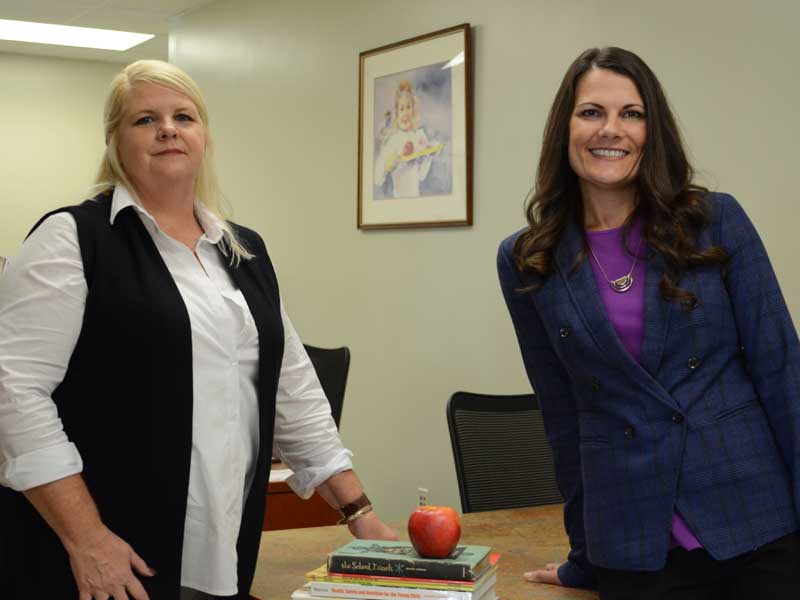by CHERYL ROGERS
The Building a Healthier Polk School Health Team is teaching kindergarten through 12th grade students how to live healthier by making wise food choices and staying active.
In an age of video games and fast foods, it’s easy to slip into bad health habits at an early age. But during the school years, there’s a chance to instill good habits through physical education classes and the school cafeteria.
At Polk County Public Schools, the Building a Healthier Polk School Health Team co-chaired by Jenna Kaczmarski and Kathleen Wright is working to develop healthier school environments in the kindergarten through 12th grade. A pilot project at five elementary schools, including Wahneta, Padgett, Inwood, Medulla and Highland City, is supporting Healthy School Teams to work on strategies to increase students’ physical activity and consumption of nutrient-dense food.
“We know that healthy school environments lead to fewer absences, higher academic achievement and higher graduation rates,” says Kaczmarski, a registered dietitian working as director of School Nutrition.
We interviewed Kaczmarski and Wright, curriculum specialist for Health and Physical Education, about the effort.
CFHN: How do you promote healthy habits in nutrition and phys ed?
JK: Our primary message is based on the 5-2-1-0 prescription. Five fruits and vegetables/day, two hours or less recreational screen time, one hour or more physical activity and zero sugary drinks. We focus on providing many vegetable and fruit choices with school meals, which sends the message that a healthy meal should always include vegetables and fruits. In an effort to keep students happy, and feel confident that we are providing healthy foods, we balance our menu with entrees made from scratch such as whole grain pasta dishes or different types of tacos, as well as traditional student favorites like chicken tenders and pizza.
Several years ago we began using monthly taste-testing opportunities to encourage our students to be brave about trying new foods. We focused primarily on fresh fruits and vegetables. This is our way of improving the likelihood that students will pick up at least one, and hopefully, more vegetables and fruits with each of their meals.
KW: [Pilot] schools host a walking or running club before school starts in the morning. Teachers are encouraged to provide five-minute brain breaks throughout the day. Schools also have a 20-minute recess scheduled daily (outside of physical education) with equipment and play space.
In the physical education classroom, healthy habits are modeled in ways such as a daily warm up and stretch before engaging in physical activity, offering/reminding students to hydrate during activity, and engaging the students in a cool down at the end of class.
Q: What do you recommend as healthy choices when students eat at fast-food restaurants?
JK: We do not do any direct education in our department about eating at fast food restaurants. But I hope they are learning that, even if you are eating a hamburger, you can pair it with fresh fruits and veggies instead of fries, and drink water or milk instead of a sugary drink. This is the example we set with our menus, and what I would recommend when eating out.
Q: How does physical education help students long term?
KW: Today’s physical education classes have a large infusion of health education, especially in the high school course most students are enrolled in called HOPE (Health Opportunities through Physical Education).
We spend a lot of instructional time on the health-related components of fitness even in elementary grades. These components are cardiorespiratory endurance, muscular strength, muscular endurance, flexibility, and body mass. In the middle and high school physical education courses, students begin to goal set based on fitness results, then create fitness plans to maintain or improve their current health. This skill can really empower our students to be engaged in monitoring their own health and, hopefully, positively affect the overall health of our community.
Q: What takeaway or takeaways do you hope to give students through your program?
JK: My hope is that students are learning how to eat healthy and maintain a healthy lifestyle now and into the future. They may not appreciate now that we ask them to take a vegetable or fruit with their meal, but later on in life I believe they will subconsciously know how to make a healthy meal.
The work we are trying to do with our pilot schools, and eventually all of our schools, takes time. We are enhancing the culture and environment present. This type of change happens slowly, but I believe the impact it will have on our students will be significant. If students are not healthy, they cannot learn and they cannot reach their full potential, so these things matter just as much as math, reading and science!
KW: My hope is that all of our students become both physically literate and health literate. Physical and health literacy not only promotes and supports our physical health, but has a huge impact on an individual’s mental health. Therefore, one could argue it is just as, or maybe even more important at times, than reading, math science and social studies.
- Anything else you would like to add?
KW: I would just like to encourage families to advocate for quality physical education in their schools. Many times physical education is seen interchangeable with recess, instruction is not expected, and equipment is lacking. The concepts we teach are too impactful to be excluded.
